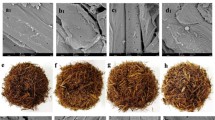Abstract
Sugarcane bagasse, a byproduct of the cane sugar industry, is an abundant source of hemicellulose that could be hydrolyzed to yield a fermentation feedstock for the production of fuel ethanol and chemicals. The effects of sulfuric acid concentration, temperature, time, and dry matter concentration on hemicellulose hydrolysis were studied with a 20-L batch hydrolysis reactor using a statistical experimental design. Even at less severe conditions considerable amounts (>29%) of the hemicellulose fraction could be extracted. The percentage of soluble oligosaccharides becomes very low in experiments with high yields in monosaccharides, which indicates that the cellulose fraction is only slightly affected. For the sugar yields, acid concentration appears to be the most important parameter, while for the formation of sugar degradation products, temperature shows the highest impact. It could be demonstrated that the dry matter concentration in the reaction slurry has a negative effect on the xylose yield that can be compensated by higher concentrations of sulfuric acid owing to a positive interaction between acid concentration and dry matter contents.
Similar content being viewed by others
References
Parisi, F. (1989), Adv. Biochem. Eng./Biotechnol. 38, 51–87.
Grohmann, K., Torget, R., and Himmel M. (1985), Biotech. Bioeng. Symp. 15, 59–80.
Grethlein, H. E. and Converse, A. O. (1991), Bioresour. Technol. 36, 77–82.
Tucker, M. P., Farmer, J. D., Keller, F. A., Schell, D. J., and Nguyen, Q. A. (1998), Appl. Biochem. Biotechnol. 70–72, 25–35.
Magee, R. J. and Kosaric, N. (1985), Adv. Biochem. Eng./Biotechnol. 32, 61–93.
Kuhad, R. C. and Singh, A. (1993), Crit. Rev. Biotechnol. 13(2), 151–172.
San Martin, R., Bushell, D., Leak, D. J., and Hartley, B. S. (1994), Biotechnol. Bioeng. 44, 12–28.
Danner, H., Madzingaidzo, L., Hartl A., and Braun, R. (1998), in Proceedings of the 10 th European Conference Biomass for Energy and Industry, Kopetz, H., Weber, T., Palz, W., Chartier, P., and Ferrero, G. L., eds., C.A.R.M.E.N., Rimpar, Wùrzburg, Germany, pp. 446–449.
Pandey, A., Soccol, C. R., Nigam, P., and Soccol, V. T. (2000), Bioresour. Technol. 74, 69–80.
Jacobsen, S. E. and Wyman, C. E. (2000), Appl. Biochem. Biotechnol. 84–86, 81–96.
Palmquist, E., Grage, H., Meinander, N. Q., and Hahn-Hägerdal, B. (1999), Biotechnol. Bioeng. 63, 46–55.
TAPPI, Technical Association of the Pulp and Paper Industry (1985), Carbohydrate Composition of Extractive-Free Wood and Wood Pulp by Gas Liquid Chromatography, TAPPI Test Methods, T249 cm-85, TAPPI, Atlanta, GA.
Effland, M. J. (1977), Tappi 60(10), 143,144.
Garrote, G., Dominguez, H., and Parajo, J. C. (1999), J. Chem. Technol. 74, 1101–1109.
Shevchenko, S. M., Chang, K., Robinson, J., and Saddler, J. N. (2000), Bioresour. Technol. 72, 207–211.
Author information
Authors and Affiliations
Corresponding author
Rights and permissions
About this article
Cite this article
Neureiter, M., Danner, H., Thomasser, C. et al. Dilute-acid hydrolysis of sugarcane bagasse at varying conditions. Appl Biochem Biotechnol 98, 49–58 (2002). https://doi.org/10.1385/ABAB:98-100:1-9:49
Issue Date:
DOI: https://doi.org/10.1385/ABAB:98-100:1-9:49




